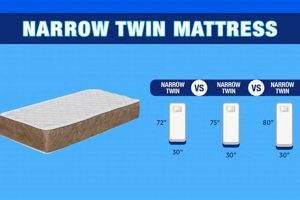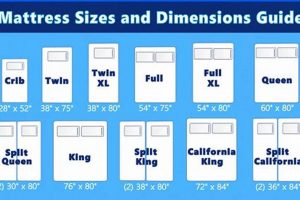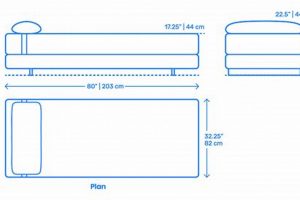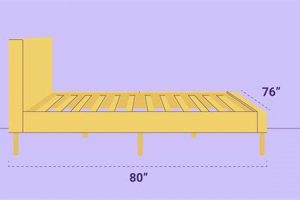The size of bedding utilized in university and college residential housing is a key consideration for students preparing for campus life. These bedding measurements are often distinct from standard residential sizes, requiring specific attention when purchasing linens and bedding accessories. For example, a typical twin mattress measures 39 inches wide and 75 inches long, while the bedding often used in dormitories may measure 36 inches wide and 80 inches long.
Appropriate bedding selections offer several advantages. Firstly, correctly sized sheets ensure a snug fit, preventing slipping and bunching during sleep, thereby promoting better rest. Secondly, understanding the exact measurements can save time and money by avoiding the purchase of ill-fitting or incompatible bedding. Historically, institutions have adopted unique sizes to maximize space utilization within residence halls.
Considering the specific bedding size used in a student’s assigned dormitory room is crucial. Subsequent discussion will explore common sizes found in student residences, methods for confirming the appropriate size for a given institution, and resources available for sourcing correctly sized bedding.
Tips Regarding Bedding Sizes in Student Residences
Selecting appropriate bedding for student residential housing requires careful attention. Ensuring correct fit maximizes comfort and longevity of bedding. The following recommendations provide guidance.
Tip 1: Verify Mattress Size Prior to Purchase: Contact the residential life office or consult the university’s housing website. Mattress sizes in student housing often differ from standard retail dimensions. Precise measurements are essential for avoiding ill-fitting bedding.
Tip 2: Prioritize Fitted Sheet Depth: Mattresses used in dormitories may be thicker than standard mattresses. Acquire fitted sheets with adequate depth to ensure a secure fit around the entire mattress perimeter. Sheet depth should exceed mattress thickness by several inches.
Tip 3: Consider Mattress Protectors: Employ a waterproof mattress protector. Dormitory mattresses experience high levels of usage. A protector safeguards against spills, stains, and potential allergen accumulation.
Tip 4: Invest in Durable Bedding Materials: Opt for bedding constructed from durable, washable materials such as cotton or microfiber blends. Frequent laundering is often necessary in a shared living environment. Select materials designed to withstand repeated washing without significant wear.
Tip 5: Utilize Bed Risers Strategically: Bed risers can elevate the bed frame, creating additional under-bed storage space. Confirm if bed risers are permissible within the specific dormitory guidelines prior to implementation. Ensure that the risers are stable and appropriate for the bed frame.
Tip 6: Laundering Matters: New bedding should be washed separately prior to its first use. This measure minimizes dye transfer and enhances fabric softness. Adhere to the manufacturers washing instructions diligently.
Implementing these tips can ensure a more comfortable and hygienic living environment within student residences. Proper planning and execution is key to maximizing the lifespan and function of bedding.
The concluding section will summarize essential considerations for making informed bedding choices and outline resources for sourcing appropriately sized and durable bedding products.
1. Size Variability
The dimensions of dormitory mattresses exhibit notable variability, necessitating careful attention from both students and institutions. This variability stems from multiple factors, each impacting the comfort and suitability of bedding.
- Institutional Standards
Educational institutions often deviate from standard mattress sizes to optimize room space and cost efficiency. These unique dimensions may necessitate specialized bedding, different from what is commonly available in retail settings. An example is the “twin XL” size, frequently utilized in dormitories, which is longer than a standard twin mattress.
- Mattress Age and Type
Older mattresses may exhibit size variations due to compression and wear over time. Furthermore, differing mattress types, such as innerspring, foam, or hybrid, can possess slightly different dimensions even when ostensibly manufactured to the same size specification. Institutions replacing mattresses may also introduce size variations with each purchase cycle.
- Manufacturer Discrepancies
Manufacturing tolerances contribute to slight dimensional differences among mattresses from different brands or even within the same product line. These discrepancies, although often minor, can affect the fit of fitted sheets and mattress protectors. Such variations highlight the importance of precise measurements.
- Regional Variations
Mattress dimensions may vary based on regional standards or prevalent practices within specific geographic locations. This is less common within the United States but can be a factor in international institutions. Understanding the regional context is vital when sourcing bedding from different locales.
The compounded effects of institutional standards, mattress age, manufacturing tolerances, and regional variations collectively contribute to the size variability encountered in dormitory mattresses. Students must verify accurate dimensions before purchasing bedding to ensure proper fit and comfort. Institutions benefit from standardizing and communicating mattress dimensions to simplify the bedding procurement process for their students.
2. Thickness Ranges
The thickness of a dormitory mattress represents a critical aspect influencing both comfort and the selection of appropriate bedding. These measurements are not standardized, requiring careful consideration to ensure optimal fit and functionality.
- Impact on Bedding Fit
Mattress thickness directly dictates the required depth of fitted sheets. A thicker mattress necessitates sheets with deeper pockets to ensure secure coverage and prevent slippage. Failure to account for thickness ranges can result in sheets that are either too tight, causing premature wear, or too loose, compromising sleep quality.
- Support and Comfort Levels
The thickness of a dormitory mattress influences its overall support and comfort characteristics. Thicker mattresses often incorporate multiple layers of varying densities to provide enhanced cushioning and pressure relief. Conversely, thinner mattresses may offer less support and are more likely to exhibit wear and tear over time, affecting sleep quality and potentially exacerbating physical discomfort.
- Compliance with Institutional Standards
Educational institutions may impose restrictions on mattress thickness to optimize space utilization and maintain uniformity within dormitory settings. Adherence to these guidelines is crucial when selecting replacement mattresses or supplemental bedding. Violations may result in non-compliance and potential replacement requirements.
- Storage Considerations
Mattress thickness can influence the availability of under-bed storage space, a premium in smaller dormitory rooms. Bulkier mattresses diminish the vertical clearance, limiting the size and quantity of items that can be stored beneath the bed. Students should evaluate both comfort preferences and storage needs when assessing mattress thickness.
Understanding the relationship between thickness ranges and bedding fit, support levels, institutional standards, and storage considerations is paramount when equipping a dormitory room. Careful attention to these facets ensures both comfort and practicality, contributing to a more positive and productive student living experience. Neglecting thickness specifications when purchasing or replacing a mattress can lead to significant challenges and discomfort throughout the academic year.
3. Material Composition
The materials used in the construction of dormitory mattresses significantly influence several key characteristics, including weight, durability, comfort, and hygiene. These factors, in turn, affect the long-term suitability and usability of the mattress within a high-traffic, shared living environment. The composition of the mattress impacts its dimensions, both initially and over time, under regular use.
- Core Material and Dimensional Stability
The core material, often innerspring, foam (polyurethane, memory foam), or a hybrid of both, determines the mattress’s capacity to maintain its specified dimensions. Innerspring cores, while providing support, may experience compression and sagging over time, slightly altering the height and surface area. Foam cores, depending on density and quality, can also compress, particularly under concentrated weight. Higher-density foams are more resistant to dimensional changes. This factor is especially relevant for twin XL dorm mattresses, where even slight changes can affect comfort.
- Cover Fabric and Overall Size
The outer cover fabric, typically cotton, polyester, or a blend, contributes to the overall mattress dimensions. Thicker, quilted covers can add to the perceived height and width. The cover material’s elasticity and resistance to stretching influence how well the mattress retains its shape. Stretched or damaged covers can distort the intended dimensions, affecting fitted sheet fit and overall structural integrity. Moisture-resistant covers are also important for hygiene maintenance within dormitory settings.
- Fire Retardant Materials and Dimension Compliance
Regulations mandate the inclusion of fire-retardant materials in mattresses. These materials, often fiberglass or chemical treatments, can affect the mattress’s overall weight and firmness, indirectly influencing its long-term dimensional stability. Compliance with fire safety standards must be balanced with maintaining the mattress’s intended size and comfort characteristics. Some newer fire retardant materials have less impact on the feel of the mattress.
- Fill Materials and Comfort Layer Impact
The comfort layers, consisting of materials like memory foam, latex, or fiberfill, contribute to the mattress’s overall thickness and surface feel. These layers can compress over time, reducing the mattress’s height and affecting its long-term comfort. The quality and density of these fill materials directly impact their ability to maintain their original volume and support, preserving the mattress’s intended dimensions and ergonomic properties.
The interplay between core material, cover fabric, fire retardants, and fill materials critically defines a dormitory mattress’s dimensional stability and overall performance. Understanding these material characteristics and their impact on size is essential for institutions and students to select mattresses that maintain their integrity and provide lasting comfort within the demanding environment of student residences. Failure to consider these aspects can lead to premature mattress degradation, reduced comfort, and increased replacement costs.
4. Durability Standards
The dimensional integrity of a dormitory mattress directly correlates with its adherence to established durability standards. These standards, often encompassing metrics for compression resistance, edge support, and fabric strength, serve to ensure that the mattress maintains its specified dimensions throughout its expected lifespan. A failure to meet these standards results in dimensional changes sagging, compression, or distortion that negatively impact comfort, support, and hygiene. For example, a mattress that compresses significantly over time will exhibit a reduced thickness, thereby altering its intended ergonomic properties and potentially leading to discomfort or back pain for the user. The link between these standards and the mattresses physical dimensions emphasizes their importance in achieving consistent performance.
The application of stringent durability standards in the manufacture of dormitory mattresses translates to tangible benefits for both students and institutions. For students, it ensures a consistent and supportive sleeping surface throughout the academic year, promoting better sleep quality and overall well-being. For institutions, it results in reduced replacement costs and maintenance efforts. Consider a scenario where a dormitory mattress lacking adequate edge support experiences premature breakdown along its perimeter. This dimensional change compromises the mattress’s structural integrity, necessitating its replacement much sooner than anticipated. Conversely, a mattress constructed according to rigorous durability standards is more likely to withstand the rigors of dormitory use, maintaining its dimensions and performance for an extended period.
In conclusion, the enforcement and adherence to durability standards are paramount in guaranteeing the long-term dimensional stability and performance of dormitory mattresses. These standards are integral to upholding student comfort, minimizing institutional costs, and ensuring compliance with health and safety regulations. Neglecting the connection between durability standards and mattress dimensions can lead to premature product failure, increased financial burden, and compromised student well-being, underlining the practical significance of this understanding within the context of student residential housing.
5. Fitted Sheet Depth
The vertical dimension of fitted sheets, known as depth, is a critical factor when selecting bedding for dormitory mattresses. This measurement determines the sheet’s ability to securely encase the mattress and prevent slippage during use. Inadequate fitted sheet depth leads to discomfort and potential damage to both the sheet and the mattress. Consideration of this dimension is crucial due to the variations in dormitory mattress dimensions.
- Mattress Thickness Variations
Dormitory mattresses often exhibit varying thicknesses due to factors such as mattress type (foam, innerspring, hybrid), age, and institutional procurement practices. These variations directly impact the required fitted sheet depth. For example, a thicker memory foam mattress necessitates a deeper pocket sheet than a thinner innerspring mattress. Failure to account for these thickness differences results in improperly fitting sheets.
- Pocket Depth Standards
Fitted sheets are available in several standard pocket depths, typically ranging from 8 inches to 22 inches. Selecting the appropriate pocket depth requires accurate measurement of the dormitory mattress’s thickness. If the mattress measures 12 inches in thickness, a fitted sheet with a pocket depth of at least 13 inches is recommended to ensure adequate coverage and prevent the corners from slipping off.
- Consequences of Insufficient Depth
Using fitted sheets with insufficient depth for a dormitory mattress leads to several undesirable outcomes. The sheet may repeatedly slip off the corners of the mattress, disrupting sleep and requiring frequent readjustment. Additionally, the stretched fabric is subjected to increased stress, leading to premature wear and tear. Prolonged use of ill-fitting sheets also compromises the mattress protector’s ability to function effectively.
- Impact on Mattress Protection
The secure fit of a fitted sheet directly influences the effectiveness of any underlying mattress protector. If the sheet is too shallow and slips off, the mattress protector becomes exposed, increasing the risk of stains, spills, and allergen accumulation. The integration of both appropriately sized fitted sheets and mattress protectors is crucial for maintaining a hygienic sleeping environment in dormitory settings.
The interconnectedness of fitted sheet depth and dormitory mattress dimensions underscores the importance of accurate measurement and informed selection. By accounting for variations in mattress thickness and choosing fitted sheets with appropriate pocket depths, students can ensure a comfortable, secure, and hygienic sleeping surface within their dormitory rooms. Overlooking this relationship can lead to discomfort, premature wear, and compromised mattress protection.
6. Water Resistance
Water resistance in a dormitory mattress is intrinsically linked to its dimensions through material composition and protective layering. A mattress’s dimensional integrity relies on its ability to repel liquids, as absorption can lead to swelling, distortion, and ultimately, a change in its intended size and shape. For instance, a mattress lacking water resistance, upon exposure to spills or accidents, may experience foam degradation and structural weakening. This degradation directly impacts its dimensions, leading to uneven surfaces and compromised support. The significance of water resistance, therefore, resides in its capacity to preserve the original dimensions and intended ergonomic properties of the mattress.
Practical applications of water-resistant technology manifest in the form of waterproof mattress covers or specialized fabric treatments applied during manufacturing. These measures act as a barrier, preventing liquids from penetrating the mattress core and causing dimensional alterations. Consider the scenario of a beverage spill on a mattress lacking water resistance. The liquid permeates the fabric, saturates the foam, and potentially leads to mold growth, which compromises the structural integrity and results in shrinkage or distortion. In contrast, a water-resistant mattress would repel the liquid, allowing for easy cleanup and preventing any long-term dimensional changes. The selection of appropriate mattress protectors or mattresses with built-in water resistance represents a proactive approach to maintaining hygiene and preserving the product’s intended lifespan.
In summary, water resistance is not merely an ancillary feature but an integral component that safeguards the dimensional stability of a dormitory mattress. The challenge lies in balancing effective water resistance with breathability and comfort. Selecting mattresses or protective measures that prioritize water resistance, while maintaining air circulation, ensures the long-term preservation of the product’s dimensions and performance, contributing to a healthier and more sustainable living environment within student residences.
7. Support Capabilities
The support capabilities of a dormitory mattress are inextricably linked to its dimensions, impacting both the ergonomic function and the longevity of the product. A mattress’s ability to provide adequate support is fundamentally determined by its internal structure, including the core material (innerspring, foam, or hybrid) and the layering of comfort materials. These structural elements, in turn, define the mattress’s overall dimensions, particularly its thickness and surface area. For instance, a mattress with insufficient thickness may lack the necessary support to prevent spinal misalignment, leading to discomfort and potential health issues. The initial dimensions of the mattress, therefore, are crucial in establishing its inherent support potential. A properly dimensioned mattress, suitable for the average user, needs to have optimal support capabilities.
Dimensional changes that occur over time directly affect support capabilities. Compression, sagging, and edge breakdown can all alter the original dimensions of the mattress, leading to a reduction in its ability to provide adequate support. Consider a dormitory mattress constructed with low-density foam or a weak innerspring system. Under continuous use, these materials may compress, resulting in a loss of thickness and the development of uneven surfaces. This dimensional change compromises the mattress’s ability to distribute weight evenly, creating pressure points and diminishing spinal support. Proper mattress support can lead to comfort and quality sleep for students.
In summary, understanding the interplay between support capabilities and dormitory mattress dimensions is paramount for institutions aiming to provide a healthy and comfortable living environment for their students. Selecting mattresses with robust internal structures and durable materials, while adhering to appropriate dimensional specifications, is critical for ensuring consistent support and preventing premature product degradation. The practical significance of this understanding lies in its ability to reduce mattress replacement costs, minimize student discomfort, and promote overall well-being within student residential housing. Ongoing assessment of mattress condition should happen to preserve its support capabilities.
Frequently Asked Questions
This section addresses commonly encountered questions regarding sizing considerations for residential hall bedding.
Question 1: Are dormitory mattress sizes standardized across all universities?
No. Bedding sizes vary between institutions and even within different residential halls at the same university. Verification of dimensions prior to linen purchase is crucial.
Question 2: What is the typical size variation encountered in dormitory mattresses?
While standard twin mattresses measure 39 inches by 75 inches, many dormitories utilize twin XL mattresses, extending the length to 80 inches. Other, less common, variations may exist.
Question 3: How can students confirm the appropriate mattress size for their assigned dormitory room?
Contacting the residential life office or consulting the university housing website are reliable methods for obtaining precise mattress dimensions.
Question 4: Does mattress thickness impact bedding selection?
Yes. Mattresses with greater thicknesses require fitted sheets with deeper pockets to ensure a secure and proper fit.
Question 5: Are mattress protectors recommended for dormitory mattresses?
Yes. Waterproof mattress protectors shield against spills, stains, and allergens, extending mattress lifespan and promoting hygiene within shared living environments.
Question 6: What are the implications of using ill-fitting bedding on a dormitory mattress?
Improperly sized bedding can slip, bunch, and cause discomfort. Additionally, it may accelerate wear and tear on both the bedding and the mattress itself.
Accurate measurement and informed purchasing decisions are key to optimizing comfort and hygiene in dormitory living spaces.
The following section will provide a list of reliable resources for sourcing appropriately sized and durable bedding products.
Conclusion
This exploration of dorm mattress dimensions underscores the significance of precise measurement and informed decision-making in equipping student residential spaces. Variations in size, thickness, material composition, and durability standards necessitate careful consideration to ensure student comfort, hygiene, and the longevity of bedding products. Understanding fitted sheet depth, water resistance, and support capabilities is equally crucial for optimizing the dormitory living experience.
The diligent application of the principles outlined herein promotes both student well-being and the efficient management of institutional resources. Continued adherence to these best practices will ensure a supportive and sustainable environment within university housing facilities.







